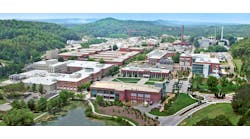Google, Fervo Turn Up Geothermal Energy System to Support Nevada Data Centers
Google has begun operating a geothermal energy system via a project years in the making to support its data centers in Nevada. In a new LinkedIn post, Michael Terrell, Senior Director for Energy and Climate at Google, called the move "a huge milestone in Google's carbon-free journey."
Terrell confirmed that the company's enhanced geothermal energy project with Fervo Energy, billed as a first-of-its-kind, is now operational and helping to power the grid serving Google's data centers in Nevada with clean electricity on a 24x7 basis.
As related by Google's recent sustainability blog featuring some excellent site photos and exhorting the potential of geothermal power:
"The U.S. Department of Energy found that geothermal energy could provide up to 120 gigawatts of reliable, flexible generation capacity in the U.S. by 2050 and generate over 16% of the U.S.’ anticipated electricity needs. Geothermal is a viable clean energy option in many regions where it’s difficult to build other renewable energy sources, notably the Asia Pacific region. Still, geothermal is not yet widely used, because traditional technologies can only be deployed economically in areas where underground heat is easily accessible."
Data Center Geothermal Power Years In the Making
As previously reported by Data Center Frontier, in 2021, Google announced it would begin using geothermal energy to power its data centers in Nevada with carbon-free energy.
That was when Google formed a groundbreaking corporate agreement with energy startup Fervo to use fiber-optic sensors to tap the earth’s own heat for the provisioning of enhanced geothermal power, the better to electrify Google Cloud servers.
"We weren’t certain that Fervo’s approach could work at a commercial scale," revealed Google's Terrell on LinkedIn. "But we were excited about the potential of enhanced geothermal technology to enable the development of geothermal resources in more areas around the world."
The Fervo system employs underground fiber-optic cables as sensors to identify the best locations to find geothermal energy.
Following successful testing of Fervo’s technology this summer, the joint project is now up and running, generating carbon-free electricity around the clock, which helps Google to reduce emissions from its data centers in Nevada, while paving the way for enhanced geothermal power on a scaleable basis.
In its blog, Google describes how it went into partnership with Fervo knowing "that a first-of-a-kind project like this would require a wide range of technical and operational innovations."
The blog notes how, unlike traditional geothermal power, Fervo uses drilling techniques pioneered by the oil and gas industry to harness heat that would have previously been difficult to access.
To tap into this subsurface heat at Google's site in Nevada, Fervo dug two horizontal wells and installed fiber-optic cables to capture data that shows the flow, temperature and performance of the geothermal system in real-time.
The result, as reckoned by Google, is a geothermal plant that can produce round-the-clock carbon pollution-free electricity (CFE) using less land than other clean energy sources. The following video shows how the system works:
Google has some history in the state of Nevada as relates to green power. In 2020, the company was seen crafting a megadeal with NV Energy to provision 350 megawatts of solar energy and 280 megawatts of energy storage to support its data center campus in Henderson, a suburb of Las Vegas.
Google has also habitually taken up moving workloads between data centers to boost its use of renewable energy, a development that creates powerful new opportunities to "greenify" cloud applications powered by solar, wind and geothermal energy.
Over the past several years, the company has been involved in myriad other pioneering efforts supporting its oft-stated drive to power its global information empire entirely with carbon-free energy by 2030, matching every hour of its data center operations to carbon-free energy sources.
Geothermal Proof Point Courtesy of Data Centers
In summary, Google's Terrell characterized the now up-and-running geothermal energy project with Fervo as "one proof point for how corporate clean energy buyers can help develop, demonstrate, and commercialize the clean electricity technologies we need to fully decarbonize electricity systems worldwide."
Notably, Google also recently announced a partnership with Project InnerSpace, a non-profit organization dedicated to the global development of geothermal energy platform, the better to accelerate the adoption of geothermal energy.
Google's recently published white paper, titled The Corporate Role in Accelerating Advanced Clean Electricity Technologies, explains why clean electricity technologies such as geothermal are critical to supplementing variable renewables, such as wind and solar, the better to cost-effectively achieve 24/7 carbon-free energy.
Keep pace with the fast-moving world of data centers and cloud computing by connecting with Data Center Frontier on LinkedIn, following us on X/Twitter and Facebook, and signing up for our weekly newsletters using the form below.

Matt Vincent
A B2B technology journalist and editor with more than two decades of experience, Matt Vincent is Editor in Chief of Data Center Frontier.





